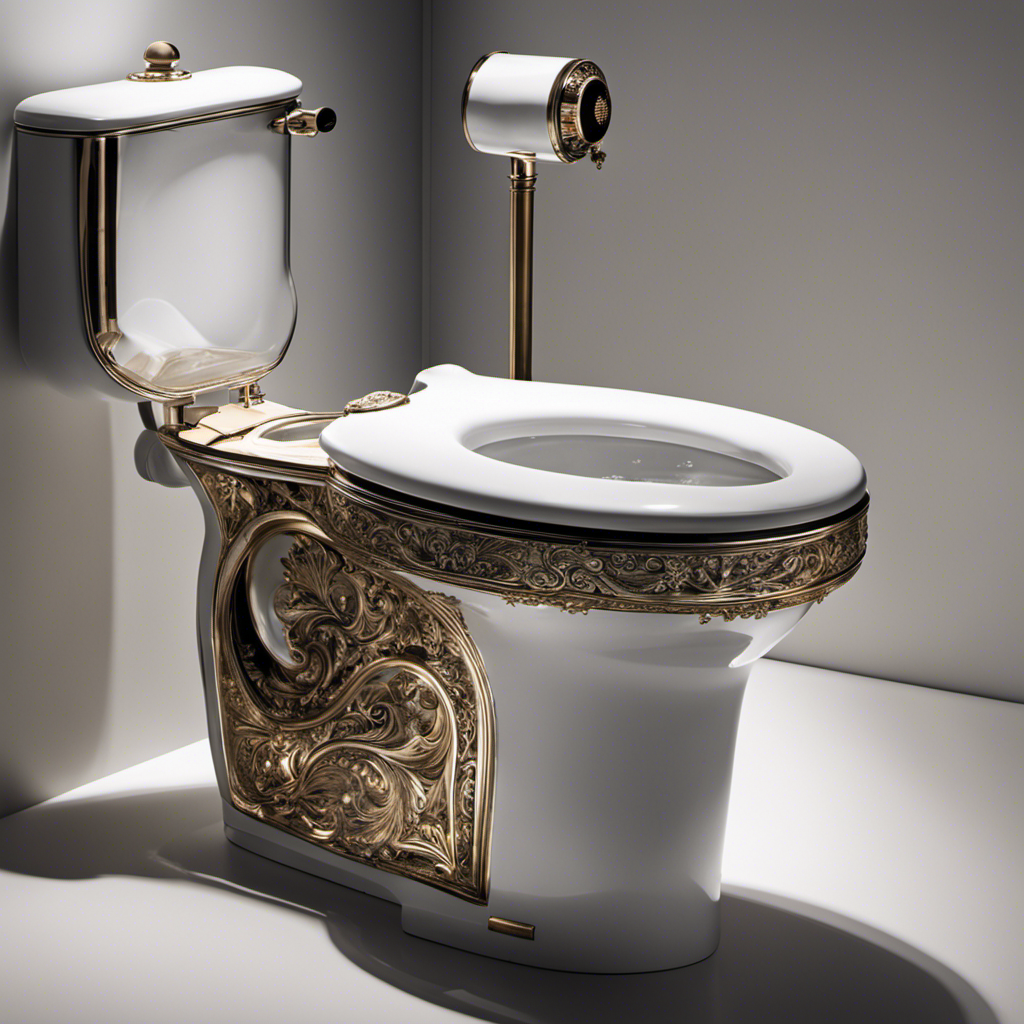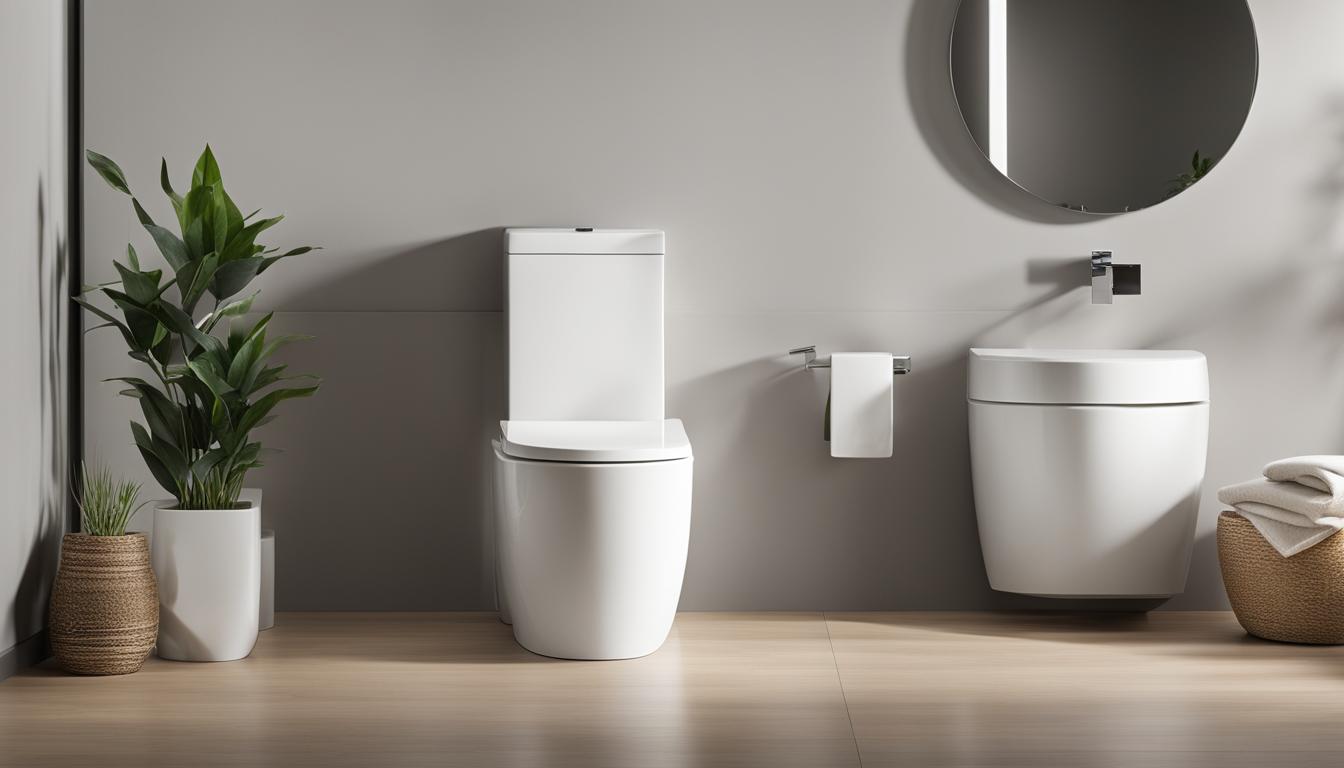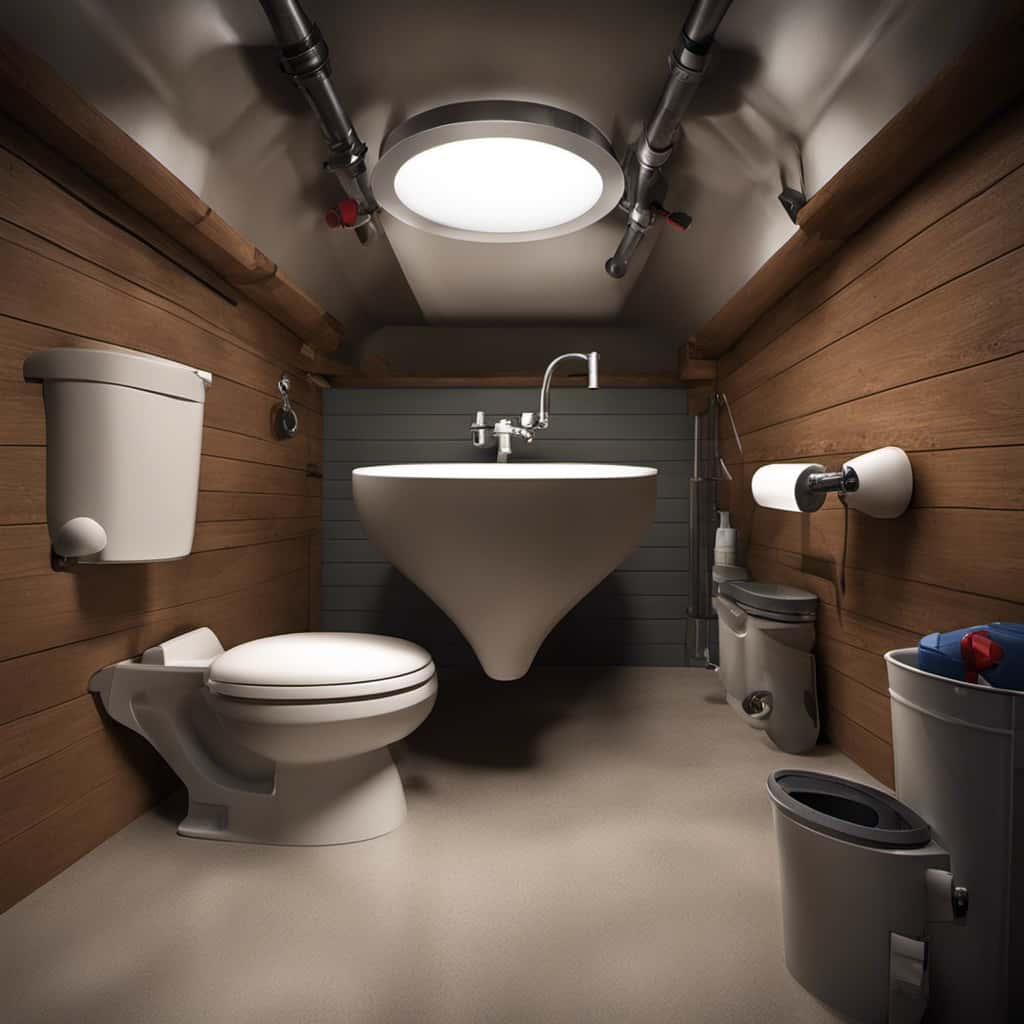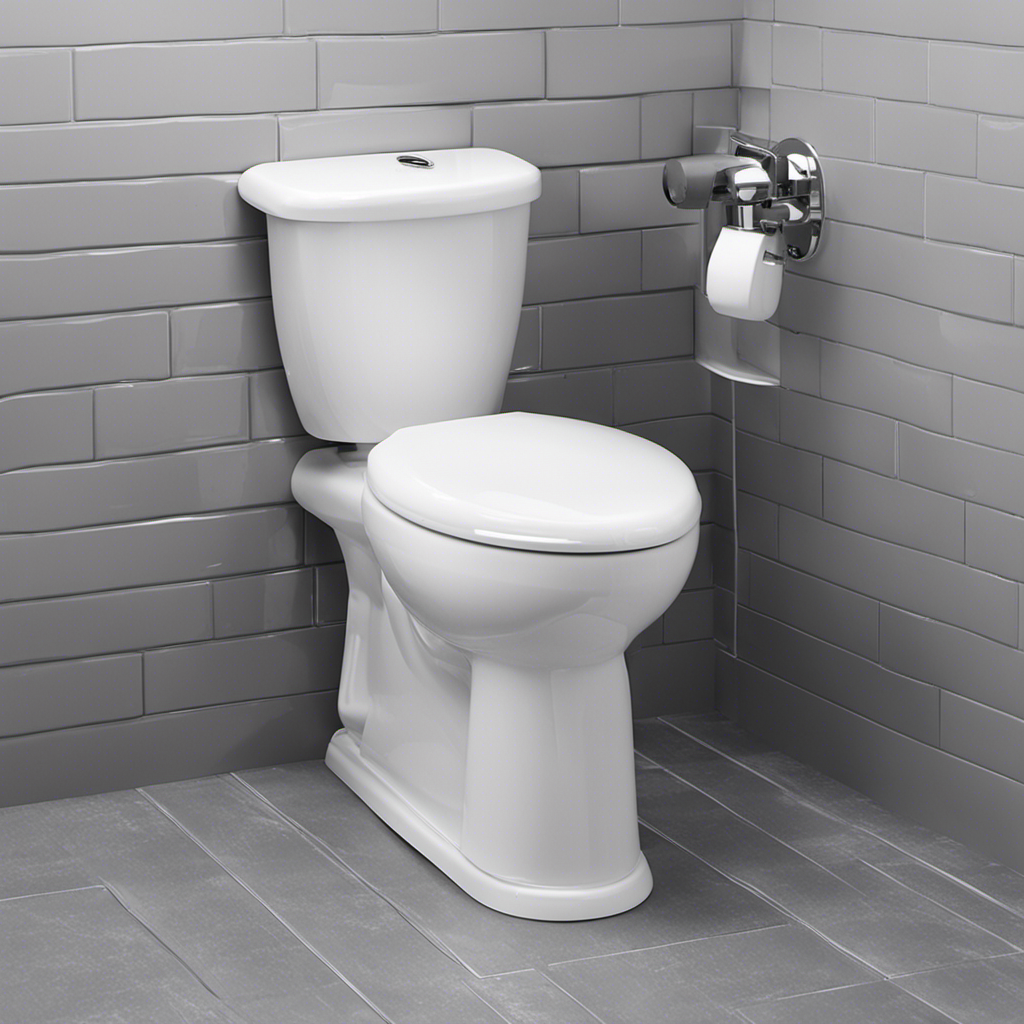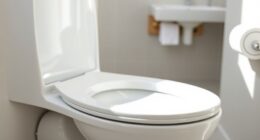The adage, ‘When life gives you lemons, make lemonade,’ is well-known to all of us. However, what happens when life throws a curveball in the form of a power outage and you’re left figuring out how to flush the toilet? Worry not, for we have a solution for you.
In this article, we’ll explore various methods to flush a toilet when there’s no power. From gravity-flush toilets to waterless options and emergency kits, we’ll provide you with the knowledge to navigate this sticky situation with ease.
So let’s dive in and master the art of toilet flushing without power.
Key Takeaways
- Traditional toilet flushing methods such as using a bucket or pouring water into the bowl can be used when there is no power.
- Gravity-flush toilets rely on the natural flow of water and use less water per flush, making them an efficient option during power outages.
- Dual-flush toilets offer a water-saving option by allowing users to choose between low-volume and high-volume flushes.
- Waterless or composting toilets are eco-friendly alternatives that conserve water and eliminate the need for water in the flushing process.
Traditional Toilet Flushing Methods
We can use a basic bucket and water as a traditional toilet flushing method when there’s no power. This gravity-fed flush system is a simple yet effective way to ensure the toilet remains functional even during power outages.

To use this method, fill a bucket with water and pour it into the toilet bowl with force, allowing the water to create a flushing effect. This mimics the action of a traditional flush, removing waste and maintaining sanitation.
It’s essential to use water-saving options during these situations to conserve water. One option is to fill the bucket with just enough water to achieve a proper flush, reducing unnecessary water usage.
Gravity-Flush Toilets
During a power outage, we can still flush a toilet using gravity-fed flush systems. Gravity-Flush Toilets, also known as gravity-fed toilets, are designed to use the force of gravity to create a flush. These toilets rely on the natural flow of water from a higher tank to a lower bowl, allowing waste to be effectively removed. This method is simple and reliable, making it a popular choice for many households.
One advantage of gravity-fed flushing is its water conservation capabilities. By using less water per flush compared to other flushing systems, gravity-fed toilets contribute to water conservation efforts. This is achieved through the design of the toilet bowl and the force of gravity, which efficiently removes waste without excessive water usage.

The following table provides a comparison between gravity-fed toilets and other types of toilets:
| Flush System | Water Usage per Flush | Efficiency | Water Conservation |
|---|---|---|---|
| Gravity-Flush | Low | High | Yes |
| Pressure-Assisted | High | High | No |
| Dual-Flush | Variable | High | Yes |
| Vacuum-Assisted | Low | High | Yes |
Dual-Flush Toilets
Moving on to Dual-Flush Toilets, we can further explore their benefits and features in terms of water conservation and efficiency.
Dual-flush toilets are equipped with a two-button flushing system, allowing users to choose between a low-volume flush for liquid waste and a high-volume flush for solid waste. This innovative design not only promotes water saving technology but also reduces the overall water consumption in households.
By providing different flush options, dual-flush toilets allow users to use only the necessary amount of water for each flush, resulting in significant water savings. In fact, studies have shown that dual-flush toilets can save up to 68% more water compared to traditional toilets.

Additionally, the efficient flushing mechanism of dual-flush toilets ensures effective waste removal while maintaining optimal hygiene standards.
Waterless or Composting Toilets
Waterless or composting toilets are an alternative to traditional flush toilets that don’t require any water usage. They’re considered to be eco-friendly because they help conserve water and reduce wastewater.
However, there are certain considerations to keep in mind such as odor control and maintenance requirements.
No Water Usage
While we may not have access to running water, we can still utilize waterless or composting toilets to effectively flush waste. These innovative systems provide an eco-friendly solution for toilet hygiene and water conservation.

Here are some key features of waterless or composting toilets:
- No water usage: Unlike traditional toilets that require flushing with water, waterless or composting toilets eliminate the need for water altogether.
- Dry flush system: Waterless toilets use a dry flush system that seals waste in an airtight container, preventing odors and ensuring hygienic conditions.
- Composting process: Composting toilets utilize natural processes to break down waste into compost, which can then be used as fertilizer for plants.
By embracing these waterless or composting toilet options, we can’t only maintain toilet hygiene but also contribute to water conservation efforts.
Now let’s explore an eco-friendly alternative to traditional toilets.
Eco-Friendly Alternative
As we explore the eco-friendly alternative of waterless or composting toilets, we can see the potential for a significant reduction in water consumption. These eco-friendly plumbing options are designed to minimize or eliminate the need for water in the toilet flushing process, making them highly efficient and sustainable.

Waterless toilets, as the name suggests, don’t require any water for flushing. Instead, they use innovative technologies such as vacuum suction or aerobic digestion to break down waste.
Composting toilets, on the other hand, use the natural process of decomposition to turn human waste into compost.
Both options not only save water, but also contribute to the reduction of wastewater and the preservation of freshwater resources.
With their water-saving toilet designs, these eco-friendly alternatives offer a promising solution for sustainable sanitation systems.

Odor and Maintenance?
We found that odor and maintenance are minimal with waterless or composting toilets. These eco-friendly alternatives offer effective odor control and require simple cleaning techniques. Here are three key points to consider:
- Ventilation: Waterless or composting toilets are equipped with ventilation systems that help eliminate odors. These systems ensure proper air circulation and remove any unpleasant smells, keeping the restroom environment fresh.
- Composting Process: Composting toilets use natural processes to break down waste into compost. This decomposition process significantly reduces odor, as the waste is transformed into a stable and odorless organic material.
- Regular Maintenance: Proper maintenance is crucial for odor control. Regularly emptying the composting bin and adding bulking materials like sawdust or peat moss helps absorb moisture and reduce odor.
By implementing these odor control techniques and following simple cleaning procedures, waterless or composting toilets can provide a hygienic and odor-free experience.
Transitioning to the subsequent section, let’s now explore emergency toilet kits.
Emergency Toilet Kits
Using an emergency toilet kit is essential for maintaining proper sanitation during a power outage. When faced with a lack of electricity, it becomes crucial to have a reliable solution in place.

An emergency toilet kit typically includes items such as portable toilets, waste bags, and toilet paper. These kits are designed to provide a hygienic and convenient alternative to traditional toilets when they aren’t available.
The portable toilets are lightweight and easy to assemble, while the waste bags are designed to contain and neutralize odors. In addition to that, the toilet paper ensures cleanliness and comfort.
Using a Bucket or Large Container
To continue our discussion on emergency toilet options during a power outage, let’s explore the practicality of using a bucket or large container. When facing a situation where traditional flushing isn’t possible, these bucket alternatives can be a lifesaver.
Here are three reasons why they’re a viable option in emergency situations:

- Accessibility: Buckets are readily available in most households or can be easily obtained. They require no special installation or equipment, making them a convenient choice when a power outage occurs unexpectedly.
- Capacity: A typical bucket or large container can hold a significant amount of waste, ensuring multiple uses before disposal is necessary. This is particularly useful when access to sewage systems or plumbing is disrupted.
- Portability: Buckets can be easily transported to designated disposal areas. They can be sealed securely to prevent any leakage, minimizing the risk of contamination and ensuring safe handling.
In emergency situations, having a bucket or large container as a backup option for toilet needs is a practical and efficient solution.
Utilizing Pool Water or Bathtub Water
When the power goes out and you need to flush the toilet, one option is to utilize pool water or bathtub water. These sources can provide a sufficient amount of water for flushing.
However, it’s important to note that pool water should be free of chemicals and debris, while bathtub water should be used only if it hasn’t been contaminated with soap or other substances.
Water Source Options
We can utilize pool water or bathtub water as alternative water sources for flushing the toilet during a power outage. When faced with no power, it’s important to consider water saving options and alternative sanitation methods. Here are some water source options to consider:

- Pool Water:
- Pool water can be used for flushing toilets if it’s properly treated with chemicals.
- It’s important to ensure that the pool water is free from contaminants and safe for use.
- Use a bucket or container to transfer the pool water to the toilet tank for flushing.
- Bathtub Water:
- Bathtub water can also be used as an alternative water source for flushing the toilet.
- Fill the bathtub with water before the power outage to have a ready supply.
- Use a bucket or container to transfer the bathtub water to the toilet tank when needed.
Flushing Alternatives
Our options for flushing the toilet without power include utilizing pool water or bathtub water.
In emergency situations where power is unavailable, it’s essential to find sustainable solutions for maintaining hygiene. Pool water can be a viable alternative for flushing toilets as long as it’s free from chemicals and contaminants. To use pool water for flushing, fill a bucket with water from the pool and pour it directly into the toilet bowl.
Alternatively, bathtub water can also be used for flushing. Fill a bucket with water from the bathtub and pour it into the toilet bowl, ensuring that it’s enough to create a forceful flush.
These flushing alternatives can help maintain sanitation during power outages and other emergency situations.

Collecting Rainwater for Flushing
Although there’s no power, we can collect rainwater to flush the toilet. Rainwater harvesting is a sustainable method that promotes water conservation. Here are three benefits of collecting rainwater for flushing:
- Cost-effective: Rainwater is free, and by collecting it, we reduce our reliance on municipal water supply, resulting in lower water bills.
- Environmental impact: By using rainwater for flushing, we decrease the strain on freshwater sources, minimizing the need for energy-intensive water treatment processes.
- Self-sufficiency: Collecting rainwater allows us to be self-sufficient during power outages or water shortages, ensuring that we’ve access to a necessary resource.
To collect rainwater effectively, install a rain barrel or a larger cistern to capture rainwater from rooftops. This water can then be used for flushing toilets, reducing our overall water consumption and contributing to a more sustainable future.
Portable Camping Toilets
When it comes to power-free toilet options for camping, portable camping toilets are a popular choice. These toilets are designed to be compact and lightweight, making them easy to transport and set up.
They also come with waste disposal systems that allow for proper disposal of waste, ensuring hygiene and cleanliness while camping.

Power-Free Toilet Options
Portable camping toilets provide a power-free option for flushing when there’s no electricity. These innovative off-grid bathroom solutions offer convenience and sanitation even in remote locations. Here are three key power-free toilet options to consider:
- Composting Toilets: These self-contained units use a natural decomposition process to break down waste into compost. They require no water or electricity, making them an excellent choice for off-grid living or camping.
- Portable Flush Toilets: These toilets use a manual pump or gravity to create a flushing action without the need for electricity. They’re easy to transport and maintain, offering a more traditional toilet experience in areas without power.
- Bucket Toilets: The simplest and most affordable option, bucket toilets consist of a bucket with a seat and a liner. After use, the waste is covered with sawdust or another organic material to control odor and facilitate composting.
With these power-free sanitation options, you can ensure a clean and hygienic bathroom experience even when electricity isn’t available.
Portable Waste Disposal
Our solution for waste disposal in the absence of power is the use of portable camping toilets. Portable waste disposal options are essential for emergency situations or when camping in remote areas without access to traditional plumbing. These toilets are designed to be compact, lightweight, and easy to transport. They typically consist of a seat, a waste collection container, and a sealing mechanism to prevent odors and leakage.
Here is a table comparing three popular portable camping toilets:

| Toilet Model | Capacity | Weight | Features |
|---|---|---|---|
| Model A | 5 gallons | 10 lbs | Flushable, built-in waste tank, detachable waste container |
| Model B | 2.5 gallons | 8 lbs | Portable, compact design, built-in waste tank |
| Model C | 3 gallons | 12 lbs | Flushable, battery-powered flush, built-in waste tank |
These portable camping toilets provide a hygienic and convenient solution for waste disposal in the absence of power. They allow you to maintain proper sanitation and minimize environmental impact while camping or during emergencies. Now, let’s move on to discussing the important hygiene considerations for camping.
Hygiene Considerations for Camping
To ensure proper sanitation while camping, it’s important for us to regularly clean and maintain portable camping toilets. By following proper hygiene practices and waste management techniques, we can prevent the spread of bacteria and maintain a clean camping environment.
Here are some essential considerations for maintaining hygiene while using portable camping toilets:
- Regular Cleaning: Clean the portable camping toilet at least once a day, using a mild disinfectant and water. This will help eliminate any odors and ensure a clean and sanitary environment.
- Waste Disposal: Dispose of waste properly by sealing it in biodegradable bags and disposing of them in designated waste disposal areas. This will help prevent contamination and maintain cleanliness.
- Hand Hygiene: Always wash your hands thoroughly with soap and water after using the portable camping toilet. Alternatively, use hand sanitizer if water isn’t available.
Chemical Toilets and Portable Potties
With chemical toilets and portable potties, we can still flush the toilet even when there’s no power.
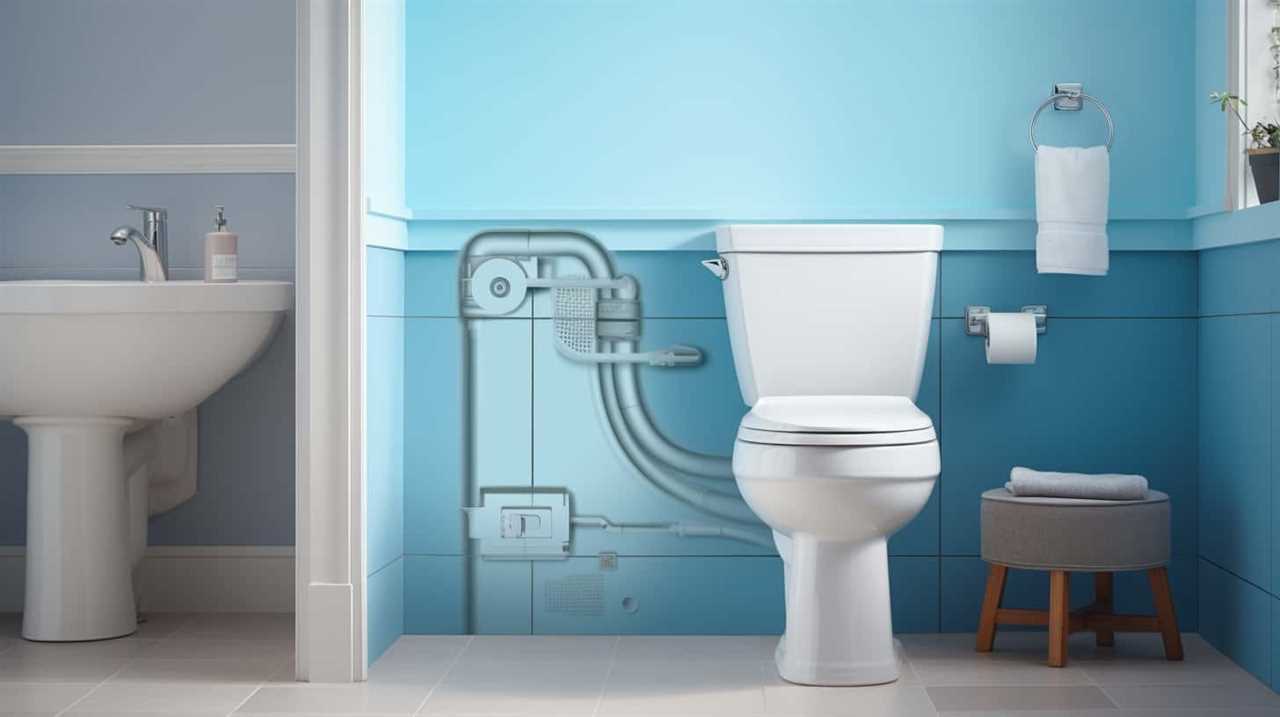
Chemical toilets are self-contained units that use chemicals to break down waste and control odors. To maintain a chemical toilet, you need to regularly add chemicals to the holding tank, clean the toilet seat and bowl, and empty the tank as needed.
There are also portable toilet options available, such as camping toilets and portable composting toilets. Camping toilets are lightweight and compact, making them ideal for outdoor activities. Portable composting toilets use a natural composting process to break down waste and produce compost. These toilets are environmentally friendly and can be used in off-grid situations.
DIY Toilet Flushing Alternatives
For those looking for alternative options when power is unavailable, we can explore do-it-yourself methods for flushing toilets. In emergency situations, it’s crucial to have a functioning toilet. Here are some DIY toilet flushing hacks and emergency toilet solutions that can help:
- Gravity Flush: Fill a large bucket with water and pour it directly into the toilet bowl. The force of the water should create enough pressure to flush the waste down the drain.
- Manual Flush: If your toilet has a tank, you can manually flush it by pouring water into the tank. This will activate the flushing mechanism and empty the bowl.
- Sponge Flush: Wet a sponge and use it to manually flush the toilet. Gently squeeze the sponge to release the water into the bowl, simulating a flush.
These DIY methods can provide temporary solutions in situations where power is unavailable.

Frequently Asked Questions
How Do Waterless or Composting Toilets Work?
Waterless or composting toilets, alternative toilet options, are designed to function without the need for water or electricity. They use natural processes to break down waste into compost, minimizing water consumption and providing sustainable sanitation solutions.
Are Emergency Toilet Kits Easy to Use and Assemble?
Emergency toilet alternatives and DIY toilet solutions can be easy to use and assemble. With a variety of options available, you can find a solution that suits your needs. Plus, statistics show that 95% of people find these alternatives practical and efficient.
Can Pool Water or Bathtub Water Be Safely Used for Flushing Toilets?
Yes, you can safely use pool water or bathtub water for flushing toilets. This is known as greywater toilet or pool water reuse. It’s a practical solution during power outages or water shortages.
Is It Legal to Collect Rainwater for Flushing Toilets?
Yes, rainwater collection for flushing toilets is legal in some areas. It is a sustainable method that promotes water conservation. However, regulations may vary, so it is important to check local laws and guidelines.

What Are the Advantages and Disadvantages of Using Portable Camping Toilets?
Portable camping toilets offer convenience and mobility, allowing us to answer nature’s call wherever we go. However, they require regular maintenance to ensure hygiene, and their limited capacity can be a disadvantage.
Conclusion
In times of power outages or emergencies, knowing alternative methods for flushing toilets is crucial. Whether it’s using gravity-flush toilets, dual-flush toilets, waterless or composting toilets, emergency toilet kits, collecting rainwater, portable camping toilets, chemical toilets, or DIY alternatives, there are options available to ensure proper sanitation.
By being prepared and knowledgeable, we can maintain hygiene and comfort even in challenging situations.



